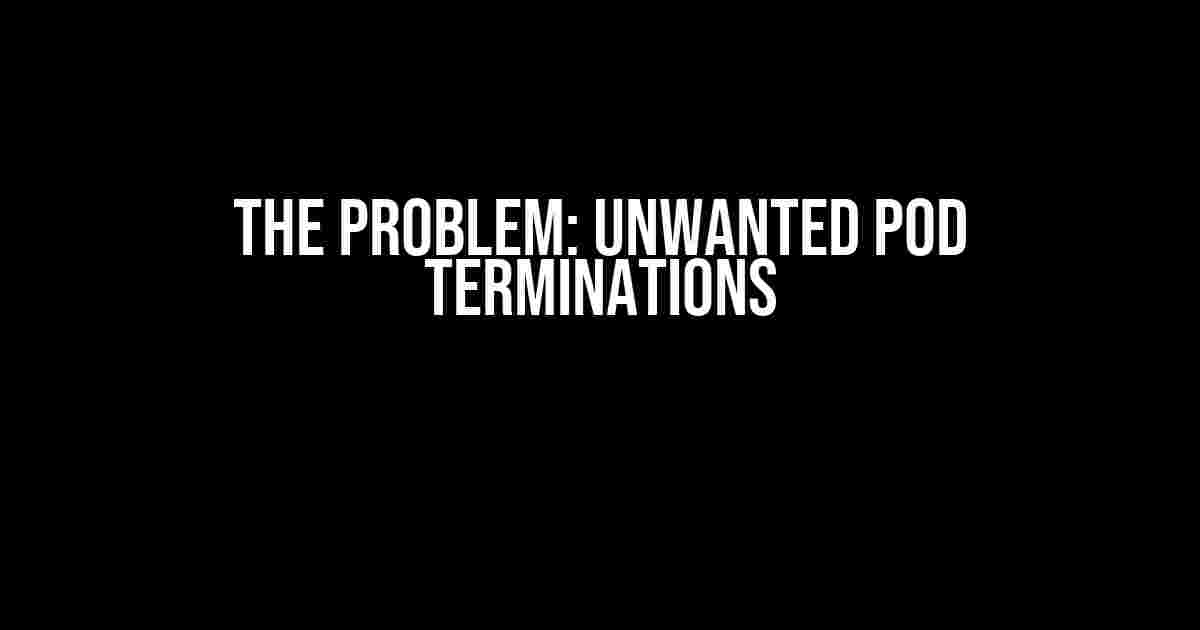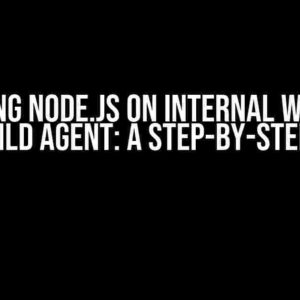Imagine this: you’re in the midst of a critical task, and suddenly, your application pod gets stopped or deleted, leaving you high and dry. It’s a nightmare scenario, especially if you’re handling sensitive data or performing a lengthy computation. The question on everyone’s mind is: can we prevent this from happening?
The Problem: Unwanted Pod Terminations
In Kubernetes, pods are ephemeral by design. They can be terminated or deleted at any moment, which is often desirable for scalability and resource management. However, this can lead to unintended consequences when an application is in the middle of a critical task. Imagine a database migration, a video rendering, or a complex scientific simulation being abruptly terminated. It’s a recipe for disaster.
Why Pods Get Deleted or Stopped
- Resource constraints: When a node runs out of resources, pods might be terminated to free up space.
- Deployment updates: During a deployment rollout, old pods might be deleted to make way for new ones.
- Node maintenance: When a node is drained for maintenance, its pods are terminated and rescheduled.
- Pod timeouts: If a pod takes too long to start or complete a task, it might be terminated.
- Human error: Accidental deletions or updates can cause pods to be terminated unintentionally.
Solutions to Prevent Pod Terminations
Luckily, Kubernetes provides mechanisms to prevent or minimize pod terminations during critical tasks. Let’s explore some solutions:
1. DeletionGracePeriodSeconds
This field in the pod specification allows you to specify a grace period during which the pod cannot be terminated. During this time, the pod will be in a ” terminating” state, and any requests to delete it will be rejected. The default value is 30 seconds, but you can adjust it according to your needs.
apiVersion: v1
kind: Pod
metadata:
name: my-pod
spec:
containers:
- name: my-container
image: my-image
terminationGracePeriodSeconds: 300
2. PodDisruptionBudget
A PodDisruptionBudget (PDB) specifies the minimum number of available pods that must be maintained at any given time. If a pod is terminated, the PDB ensures that there’s always a minimum number of replicas available. You can create a PDB for a specific pod or for a collection of pods using a selector.
apiVersion: policy/v1
kind: PodDisruptionBudget
metadata:
name: my-pdb
spec:
minAvailable: 1
selector:
matchLabels:
app: my-app
3. Readiness Probes
A readiness probe is a way to determine if a container is ready to receive traffic. If a pod is not ready, it won’t be terminated until it becomes ready again. You can implement a readiness probe using an HTTP request, a TCP socket, or an executable command.
apiVersion: v1
kind: Pod
metadata:
name: my-pod
spec:
containers:
- name: my-container
image: my-image
readinessProbe:
httpGet:
path: /healthz
port: 8080
initialDelaySeconds: 5
timeoutSeconds: 1
4. PreStop Hook
A preStop hook is a way to execute a command or an HTTP request before a pod is terminated. This allows your application to perform cleanup tasks, such as saving its state or releasing resources.
apiVersion: v1
kind: Pod
metadata:
name: my-pod
spec:
containers:
- name: my-container
image: my-image
lifecycle:
preStop:
exec:
command: ["my-cleanup-command"]
Additional Considerations
While these solutions can help prevent pod terminations, it’s essential to consider the following:
- Pod Priority and Preemption: If a high-priority pod needs to be scheduled, it might preempt a lower-priority pod, leading to termination.
- Node Eviction: If a node is evicted or drained, its pods will be terminated, regardless of any prevention mechanisms.
- Pod Restart Policies: If a pod restarts, it might be terminated again if the underlying issue isn’t resolved.
Conclusion
In conclusion, while it’s not possible to completely prevent a pod from being stopped or deleted, Kubernetes provides various mechanisms to minimize the likelihood of terminations during critical tasks. By using DeletionGracePeriodSeconds, PodDisruptionBudget, readiness probes, and preStop hooks, you can ensure that your application has a better chance of completing its tasks uninterrupted.
Remember to carefully evaluate your application’s requirements and implement a combination of these solutions to achieve the desired level of reliability. With Kubernetes, you can strike a balance between resource management and application availability.
So, the next time your application is in the midst of a critical task, you can rest assured that you’ve taken the necessary steps to prevent unwanted pod terminations. Happy coding!
| Solution | Description |
|---|---|
| DeletionGracePeriodSeconds | Specifies a grace period during which the pod cannot be terminated. |
| PodDisruptionBudget | Ensures a minimum number of available pods are maintained at any given time. |
| Readiness Probes | Determines if a container is ready to receive traffic, preventing termination until it becomes ready again. |
| PreStop Hook | Executes a command or HTTP request before a pod is terminated, allowing for cleanup tasks. |
Final Thoughts
In the world of Kubernetes, pod terminations are a reality. However, by understanding the reasons behind pod deletions and implementing the solutions outlined in this article, you can minimize the risk of unwanted terminations and ensure your application completes its critical tasks uninterrupted.
Remember, Kubernetes is all about finding a balance between resource management and application availability. By mastering the art of pod management, you can create robust, scalable, and highly available applications that meet the demands of modern software development.
So, go ahead and take control of your pods. The fate of your application depends on it!
Frequently Asked Question
In the world of Kubernetes, pod management can be a delicate affair. What if you’re in the middle of a critical task and your pod gets stopped or deleted? Can you prevent it from happening?
Can I configure my pod to ignore deletion requests?
While there’s no direct way to completely ignore deletion requests, you can use a deletionGracePeriodSeconds to delay the deletion process. This allows your pod to finish its task before shutting down. However, it’s essential to note that this method only delays the inevitable; your pod will still be deleted eventually.
How can I prevent a pod from being stopped while it’s running a critical task?
One approach is to use a liveness probe to detect when your pod is running a critical task. If the probe determines that the task is still in progress, it can prevent the pod from being stopped or deleted. You can also use a combination of readiness and liveness probes to achieve this.
Is there a way to make my pod “undeletable”?
Sorry, but it’s not possible to make a pod completely “undeletable”. Kubernetes is designed to manage and orchestrate pods, and deletion is an essential part of that process. However, you can use Kubernetes features like Persistent Volumes and StatefulSets to ensure that your data is preserved even if a pod is deleted.
Can I use finalizers to prevent a pod from being deleted?
Finalizers can be used to delay the deletion of a pod, but they won’t prevent it entirely. A finalizer is a mechanism to allow a controller to implement additional logic before the deletion of an object. You can use finalizers to ensure that your pod completes any critical tasks before it’s deleted, but eventually, the deletion will still occur.
Are there any alternative approaches to preventing pod deletion?
Yes, there are! Instead of trying to prevent pod deletion, you can focus on making your application resilient to pod failures. This can be achieved through techniques like stateless applications, self-healing services, and idempotent operations. By designing your application to be fault-tolerant, you can ensure that even if a pod is deleted, your service will continue to run smoothly.



